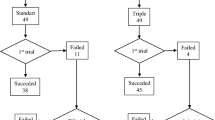Abstract
Objective
I-gel is a noncuff type of laryngeal airway mask. No horizontal line has yet been determined as an ideal position for pediatric sizes because of the variability in length of the oropharyngeal–laryngeal arch in children. We investigated whether there is a correlation between insertion length and patient body weight or height for the pediatric I-gel sizes from 1.5 to 2.5.
Methods
With parental informed consent, we planned to maintain the airway of 130 children aged from 7 months to 13 years by using the I-gel device under general anesthesia. The following two parameters were evaluated: (1) distance between the teeth and the connector wing; (2) insertion length (distance from the distal end of the gastric tube to the teeth). Size selection was determined on the basis of patients’ body weight. We identified the relationship between each parameter and height or weight.
Results
Average insertion length became gradually longer with increasing height and weight. Spearman’s R between insertion length and height or weight was 0.8. There was more correlation with height than with weight in pediatric size 2.5.
Conclusion
Results suggested that it is possible to draw an ideal line on the I-gel with sizes 1.5 and 2 only.





Similar content being viewed by others
References
Miyasaka K, Suzuki Y, Kondo Y, Sakai H, Nakagawa S, Asahara S. The use of the laryngeal mask airway in pediatric anesthesia. J Anesth. 1991;5(2):160–5 (Epub 1991/04/01).
Pennant JH, White PF. The laryngeal mask airway. Its uses in anesthesiology. Anesthesiology. 1993;79(1):144–63 (Epub 1993/07/01).
Pinosky M. Laryngeal mask airway: uses in anesthesiology. South Med J. 1996;89(6):551–5 (Epub 1996/06/01).
Theiler LG, Kleine-Brueggeney M, Luepold B, Stucki F, Seiler S, Urwyler N, Greif R. Performance of the pediatric-sized i-gel compared with the Ambu AuraOnce laryngeal mask in anesthetized and ventilated children. Anesthesiology. 2011;115(1):102–10 (Epub 2011/05/17).
Hughes C, Place K, Berg S, Mason D. A clinical evaluation of the I-gel supraglottic airway device in children. Paediatr Anaesth. 2012;22(8):765–71 (Epub 2012/06/08).
Maitra S, Baidya DK, Bhattacharjee S, Khanna P. Evaluation of i-gel™ airway in children: a meta-analysis. Paediatr Anaesth. 2014;24(10):1072–9 (Epub 2014/07/22).
Abukawa Y, Hiroki K, Ozaki M. Initial experience of the i-gel supraglottic airway by the residents in pediatric patients. J Anesth. 2012;26(3):357–61 (Epub 2012/02/09).
Taxak S, Bhardwaj M, Gopinath A. The i-gel™—a promising airway device for magnetic resonance imaging suite. J Anaesthesiol, clin pharmacol. 2012;28(2):263–4 (Epub 2012/05/05).
Corso RM, Battelli D, Maitan S, Zampone S, Agnoletti V. A clinical evaluation of the pediatric i-gel for airway management during MRI examination. J Anaesthesiol, clin pharmacol. 2014;30(2):288–90 (Epub 2014/05/08).
Russo SG, Cremer S, Eich C, Jipp M, Cohnen J, Strack M, Quintel M, Mohr A. Magnetic resonance imaging study of the in vivo position of the extraglottic airway devices i-gel and LMA-Supreme in anaesthetized human volunteers. Br J Anaesth. 2012;109(6):996–1004 (Epub 2012/09/28).
Pant D, Koul A, Sharma B, Sood J. A comparative study of Laryngeal Mask Airway size 1 vs. i-gel size 1 in infants undergoing daycare procedures. Paediatr Anaesth. 2015;25(4):386–91 (Epub 2014/10/14).
Kayhan GE, Begec Z, Sanli M, Gedik E, Durmus M. Performance of size 1 I-gel compared with size 1 ProSeal laryngeal mask in anesthetized infants and neonates. Sci World J. 2015;2015:426186 (Epub 2015/03/21).
Author information
Authors and Affiliations
Corresponding author
Ethics declarations
Conflict of interest
The authors declare that there is no conflict of interest regarding the publication of this paper.
Funding
This study was supported in part by internal university’s clinical research budget.
About this article
Cite this article
Abukawa, Y., Hiroki, K., Iwakiri, H. et al. Challenge to pediatric anatomical variation : Can we draw the ideal line on the pediatric I-gel?. J Anesth 30, 199–204 (2016). https://doi.org/10.1007/s00540-015-2108-7
Received:
Accepted:
Published:
Issue Date:
DOI: https://doi.org/10.1007/s00540-015-2108-7




